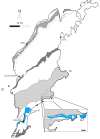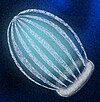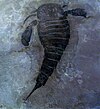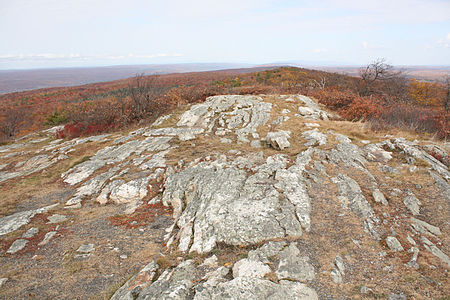IntroductionSelected article on the Silurian world and its legacies
Ctenophora is a phylum of marine animals characterized by "combs" consisting of cilia they use for swimming. Adults range from a few millimeters to 1.5 m (4 ft 11 in) in size. Their bodies consist of a mass of jelly, with one layer two cells thick on the outside and another lining the internal cavity. Almost all ctenophores consume tiny animal prey. The phylum has a wide range of body forms, including the egg-shaped cydippids with retractable tentacles that capture prey, the flat generally combless platyctenids, and the large-mouthed beroids, which prey on other ctenophores.
Despite their soft, gelatinous bodies, fossils thought to represent ctenophores have been found in lagerstätten as far back as the early Cambrian, about 525 million years ago. The position of the ctenophores in the tree of life has long been debated, and the majority view at present, based on molecular phylogenetics, is that ctenophores are more primitive than the sponges, which are more primitive than the cnidarians and bilaterians. A recent molecular phylogenetics analysis concluded that the common ancestor of all modern ctenophores was cydippid-like, and that all the modern groups appeared relatively recently, probably after the Cretaceous–Paleogene extinction event 66 million years ago. Evidence accumulating since the 1980s indicates that the "cydippids" are not monophyletic, in other words do not include all and only the descendants of a single common ancestor, because all the other traditional ctenophore groups are descendants of various cydippids. (see more...) Selected article on the Silurian in human science, culture and economics
Paleontology or palaeontology (/ˌpeɪliɒnˈtɒlədʒi, ˌpæli-, -ən-/) is the scientific study of prehistoric life. It includes the study of fossils to determine organisms' evolution and interactions with each other and their environments (their paleoecology). As a "historical science" it attempts to explain causes rather than conduct experiments to observe effects. Paleontological observations have been documented as far back as the 5th century BC. The science became established in the 18th century as a result of Georges Cuvier's work on comparative anatomy, and developed rapidly in the 19th century. The term itself originates from Greek: παλαιός (palaios) meaning "old, ancient," ὄν, ὀντ- (on, ont-), meaning "being, creature" and λόγος (logos), meaning "speech, thought, study".
Paleontology lies on the border between biology and geology. It now uses techniques drawn from a wide range of sciences, including biochemistry, mathematics and engineering. Use of all these techniques has enabled paleontologists to discover much of the evolutionary history of life, almost all the way back to when Earth became capable of supporting life, about 3,800 million years ago. As knowledge has increased, paleontology has developed specialized sub-divisions, some of which focus on different types of fossil organisms while others study ecology and environmental history, such as ancient climates. Body fossils and trace fossils are the principal types of evidence about ancient life, and geochemical evidence has helped to decipher the evolution of life before there were organisms large enough to leave fossils. (see more...) Selected image
Did you know?
Need help?Do you have a question about Abyssal/Portal:Silurian that you can't find the answer to? Consider asking it at the Wikipedia reference desk. GeochronologyEpochs - Llandovery - Wenlock - Ludlow - Pridoli Plants - Lycopods - Rhyniophytes - Vascular plants Fossil sites - Yea Flora Fossil Site Researchers - Increase A. Lapham - Roderick Murchison Quality ContentFeatured Silurian articles - Fungus SubcategoriesRelated contentAssociated WikimediaThe following Wikimedia Foundation sister projects provide more on this subject:
|





















